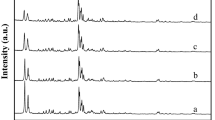Abstract
The presence of zirconium dioxide (ZrO2) greatly increases H2 yields in water radiolysis, an inevitable process which takes place in nuclear power plants. The aim of this review is to compile available knowledge about ZrO2 effect on H2 yields. The following parameters taken into consideration include: (i) LET of radiation, (ii) form of the adsorbed water, (iii) presence of oxygen, (iv) surface area, (v) crystalline structure, (vi) size of particles, (vii) doping with other oxides, (viii) grafting, and (ix) catalytic decomposition of H2O2.





Similar content being viewed by others
References
Draganić IG (2005) Radiolysis of water: a look at its origin and occurrence in the nature. Radiat Phys Chem 72:181–186
Roth O, Trummer M, Jonsson M (2009) Factors influencing the rate of radiation-induced dissolution of spent nuclear fuel. Res Chem Intermed 35:465–478
Lefebvre F, Lemaignan C (1997) Irradiation effects on corrosion of zirconium alloy claddings. J Nucl Mater 248:268–274
Lousada CM, Jonsson M (2010) Kinetics, mechanism, and activation energy of H2O2 decomposition on the surface of ZrO2. J Phys Chem C 114:11202–11208
Garibov A (2005) Radiation-heterogenic processes of hydrogen accumulation in water-cooled nuclear reactors. Nukleonika 56:333–342
Le Caër S (2011) Water radiolysis: influence of oxide surfaces on H2 production under ionizing radiation. Water 3:235–253
Jonsson M (2014) An overview of interfacial radiation chemistry in nuclear technology. Isr J Chem 54:292–301
LaVerne JA (2010) Radiation chemistry of water with ceramic oxides. In: Hatano Y, Katsumura Y, Mozumder A (eds) Charged particle and photon interactions with matter: recent advances, applications and interfaces, 1st edn. CRC Press, Boca Raton
Zielinski A, Sobieszczyk S (2011) Hydrogen-enhanced degradation and oxide effects in zirconium alloys for nuclear applications. Int J Hydrog Energy 36:8619–8629
Thiel PA, Madey TE (1987) The interaction of water with solid surfaces: fundamental aspects. Surf Sci Rep 7:211–385
Petrik NG, Alexandrov AB, Vall AI (2001) Interfacial energy transfer during gamma radiolysis of water on the surface of ZrO2 and some other oxides. J Phys Chem B 105:5935–5944
Essehli R, Crumière F, Blain G, Vandenborre J, Pottier F, Grambow B, Fattahi M, Mostafavi M (2011) H2 production by γ and He ions water radiolysis, effect of presence TiO2 nanoparticles. Int J Hydrogen Energy 36:14342–14348
Caffrey JM, Allen AO (1958) Radiolysis of pentane adsorbed on mineral solids. J Phys Chem 62:33–37
LaVerne JA, Tandon L (2002) H2 production in the radiolysis of water on CeO2 and ZrO2. J Phys Chem B 106:380–386
LaVerne JA, Tandon L (2003) H2 production in the radiolysis of water on UO2 and other oxides. J Phys Chem B 107:13623–13628
Roth O, Dahlgren B, LaVerne JA (2012) Radiolysis of water on ZrO2 nanoparticles. J Phys Chem C 116:17619–17624
Henderson MA (2002) The interaction of water with solid surfaces: fundamental aspects revisited. Surf Sci Rep 46:1–308
Carrasco-Flores EA, LaVerne JA (2007) Surface species produced in the radiolysis of zirconia nanoparticles. J Chem Phys 127:234703–234709
LaVerne JA (2005) H2 formation from the radiolysis of liquid water with zirconia. J Phys Chem B Lett 109:5395–5397
Alam M, Miserque F, Taguchi M, Boulanger L, Renault P (2009) Tuning hydrogen production during oxide irradiation through surface grafting. J Mater Chem 19:4261–4267
Lousada CM, Johansson AJ, Brinck T, Jonsson M (2012) Mechanism of H2O2 decomposition on transition metal oxide surfaces. J Phys Chem C 116:9533–9543
Lousada CM, LaVerne JA, Jonsson M (2013) Enhanced hydrogen formation during the catalytic decomposition of H2O2 on metal oxide surfaces in the presence of HO radical scavengers. Phys Chem Chem Phys 15:12674–12679
Dimitrijevic NM, Henglein A, Meisel D (1999) Charge separation across the silica nanoparticle/water interface. J Phys Chem B 103:7073–7076
Schatz T, Cook AR, Meisel D (1999) Capture of charge carriers at the silica nanoparticle-water interface. J Phys Chem B 103:10209–10213
Meisel D (2004) Radiation effects in nanoparticle suspensions. In: Lin-Marzan L, Kamat P (eds) Nanoscale materials, 1st edn. Springer, Berlin
Cecal A, Goanta M, Palamaru M, Stoicescu T, Popa K, Paraschivescu A, Anita V (2001) Use of some oxides in radiolytical decomposition of water. Radiat Phys Chem 62:333–336
Yamada R, Nagaishi R, Hatano Y, Yoshida Z (2008) Hydrogen production in the γ-radiolysis of aqueous sulfuric acid solutions containing Al2O3, SiO2, TiO2 or ZrO2 fine particles. Int J Hydrogen Energy 33:929–936
Acknowledgments
Financial support under Research Task No. 7 “Study of hydrogen generation processes in nuclear reactors under regular operation conditions and in emergency cases, with suggested actions aimed at upgrade of nuclear safety” financed by the National Research and Development Centre in the framework of the Strategic Research Project entitled “Technologies Supporting Development of Safe Nuclear Power Engineering” is greatly acknowledged.
Author information
Authors and Affiliations
Corresponding author
Rights and permissions
About this article
Cite this article
Skotnicki, K., Bobrowski, K. Molecular hydrogen formation during water radiolysis in the presence of zirconium dioxide. J Radioanal Nucl Chem 304, 473–480 (2015). https://doi.org/10.1007/s10967-014-3856-9
Received:
Published:
Issue Date:
DOI: https://doi.org/10.1007/s10967-014-3856-9




